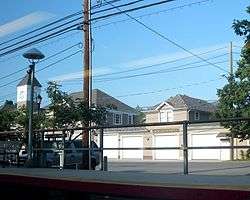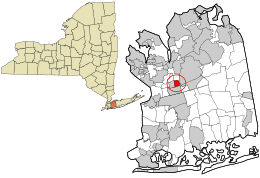East Williston, New York
East Williston is an incorporated village in Nassau County, New York in the United States. The population was 2,556 at the 2010 census.
East Williston, New York | |
|---|---|
Village | |
| Incorporated Village of East Williston | |
 | |
 Location in Nassau County and the state of New York. | |
 East Williston, New York Location within the state of New York | |
| Coordinates: 40°45′35″N 73°38′0″W | |
| Country | |
| State | |
| County | Nassau |
| Town | North Hempstead |
| Inc. Village | 1926 |
| Government | |
| • Type | Village Board |
| • Mayor | Bonnie Parente |
| • Trustee / Deputy Mayor | Christopher Siciliano |
| • Trustee | James Iannone |
| • Trustee | James Lark |
| • Trustee | Raffaela Dunn |
| Area | |
| • Total | 0.57 sq mi (1.47 km2) |
| • Land | 0.57 sq mi (1.47 km2) |
| • Water | 0.00 sq mi (0.00 km2) |
| Elevation | 118 ft (36 m) |
| Population (2010) | |
| • Total | 2,556 |
| • Estimate (2019)[2] | 2,550 |
| • Density | 4,481.55/sq mi (1,731.34/km2) |
| Time zone | UTC-5 (Eastern (EST)) |
| • Summer (DST) | UTC-4 (EDT) |
| ZIP code | 11596 |
| Area code(s) | 516 |
| FIPS code | 36-23217 |
| GNIS feature ID | 0949275 |
| Website | www |
The Incorporated Village of East Williston is in the Town of North Hempstead. It is represented on North Hempstead's Town Board by Councilman Peter Zuckerman.
History
Most of the farmland was owned by the Willis family in the 1800s. So as not to be confused with the Willis areas of upstate New York, this area was known as East Williston. The original borders of the area known as East Williston, stretched west towards Queens to Herricks Road; north to I.U. Willets Road; south to the Village of Mineola; and east to Bacon Road in Old Westbury.
The coming of the railroad in 1865 stimulated manufacturing in East Williston. The industries that grew as a result of the new train station included brick making, windmill making and carriage making. Henry M. Willis designed and built the popular East Williston Runabout Roadcart. This carriage had two wheels and two seats. Its soft suspension allowed comfortable travel over the rough roads of the time.[3] There was also a feature which allowed the body to be locked to the axle, allowing the carriage to be used on the racetrack. Over 1,000 East Williston Runabout Roadcarts were built by Oakley and Griffin (who purchased the business from Willis in 1889).[4]
The major east-west route, State Route 25B or Hillside Avenue, was formerly called East Williston Avenue, since it connected Queens with East Williston. A small portion of the area was incorporated in 1926 as the Village of East Williston. The East Williston Union Free School District was founded in 1955. In 1985, the residential and commercial core of East Williston collectively known as the East Williston Village Historic District was designated a national historic district and listed on the National Register of Historic Places.[5]
Geography

East Williston is located at 40°45′35″N 73°38′0″W (40.759688, -73.633225).[6]
According to the United States Census Bureau, the village has a total area of 0.6 square miles (1.6 km2), all land.
Demographics
| Historical population | |||
|---|---|---|---|
| Census | Pop. | %± | |
| 1930 | 493 | — | |
| 1940 | 1,152 | 133.7% | |
| 1950 | 1,734 | 50.5% | |
| 1960 | 2,940 | 69.6% | |
| 1970 | 2,808 | −4.5% | |
| 1980 | 2,708 | −3.6% | |
| 1990 | 2,515 | −7.1% | |
| 2000 | 2,503 | −0.5% | |
| 2010 | 2,556 | 2.1% | |
| Est. 2019 | 2,550 | [2] | −0.2% |
| U.S. Decennial Census[7] | |||
As of the census[8] of 2000, there were 2,503 people, 833 households, and 717 families residing in the village. The population density was 4,447.5 people per square mile (1,725.7/km2). There were 846 housing units at an average density of 1,503.2 per square mile (583.3/km2). The racial makeup of the village was 95.25% White, 0.36% African American, 0.04% Native American, 3.36% Asian, 0.08% Pacific Islander, 0.24% from other races, and 0.68% from two or more races. Hispanic or Latino of any race were 2.36% of the population.
There were 833 households, out of which 42.5% had children under the age of 18 living with them, 77.4% were married couples living together, 6.4% had a female householder with no husband present, and 13.9% were non-families. 12.7% of all households were made up of individuals, and 8.8% had someone living alone who was 65 years of age or older. The average household size was 3.00 and the average family size was 3.29.
In the village, the population was spread out, with 28.2% under the age of 18, 5.8% from 18 to 24, 22.7% from 25 to 44, 27.8% from 45 to 64, and 15.5% who were 65 years of age or older. The median age was 41 years. For every 100 females, there were 95.4 males. For every 100 females age 18 and over, there were 90.7 males.
The median income for a household in the village was $109,111, and the median income for a family was $118,611. Males had a median income of $90,952 versus $44,861 for females. The per capita income for the village was $50,484. About 1.4% of families and 1.7% of the population were below the poverty line, including 2.6% of those under age 18 and 1.0% of those age 65 or over.
Notable people
- Carol Alt, supermodel and actress
- Michael Balboni, former NYS Senator 7th District, former Director of NYS Office of Homeland Security
- John D. Caemmerer (1928-1982), lawyer and politician who served in the New York Senate.[9]
- Jack Kirby, comic book artist, co-creator of Captain America, the X-Men, the Fantastic Four and numerous other characters.[10]
- Carol Leifer, writer and comedian
- Christopher Masterson, actor
- Danny Masterson, actor
- Maureen Ryan O'Connell, former NYS Assemblywoman 17th District, Nassau County Clerk[11]
- Joseph Schindelman, illustrator of original US edition of Charlie and The Chocolate Factory, by Roald Dahl.[12]
References
- "2019 U.S. Gazetteer Files". United States Census Bureau. Retrieved July 27, 2020.
- "Population and Housing Unit Estimates". United States Census Bureau. May 24, 2020. Retrieved May 27, 2020.
- Weidman, Bette S. and Linda B. Martin. Nassau County Long Island In Early Photographs: 1869-1940. Dover Publications Inc., 1981. ISBN 0-486-24136-X
- Aronson, Harvey, ed. Home Town Long Island. (Newsday, 1999). ISBN 1-885134-21-5.
- "National Register Information System". National Register of Historic Places. National Park Service. March 13, 2009.
- "US Gazetteer files: 2010, 2000, and 1990". United States Census Bureau. 2011-02-12. Retrieved 2011-04-23.
- "Census of Population and Housing". Census.gov. Retrieved June 4, 2015.
- "U.S. Census website". United States Census Bureau. Retrieved 2008-01-31.
- Staff. "John Caemmerer, Chairman Of State Senate Transit Panel", The New York Times, February 8, 1982. Accessed November 29, 2017. "Mr. Caemmerer, who was born in Brooklyn, grew up in suburban East Williston. It was there, the burly Mr. Caemmerer once said, that he came to appreciate mass-transit needs as a student commuting to Xavier High School in Manhattan."
- Kirby, Neal. "Growing up Kirby: The Marvel memories of Jack Kirby's son". LA Times. Retrieved 2015-05-19.
- Office of the County Clerk Archived 2010-05-28 at the Wayback Machine.
- Tedesco, Richard. "Wonka Artist Is Local". Mineola American. Retrieved 2015-05-19.
External links
- Inc. Village of East Williston
- East Williston Fire Department
- Patent Number 447391, for the popular Road Cart invented by Henry M. Willis.